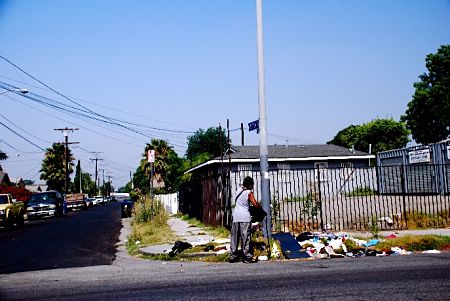In South Los Angeles, Disparities in Health, Access to Healthy Food Persist

In "LaVonna's World," people in South Los Angeles are able to buy healthy, fresh food at reasonable prices in grocery stores near their homes. They're able to see a specialist when they need to and get the health insurance they need. They don't suffer disproportionately from diseases like diabetes and asthma.
It's going to take some time to get there, said LaVonna V. Lewis, a USC School of Policy, Planning and Development researcher who studies health disparities.
In addition to higher rates of asthma, diabetes, heart disease and lack of insurance, people living in South Los Angeles communities like Watts and Compton also die prematurely in far greater numbers than their counterparts in wealthier areas of Los Angeles County, Lewis said. In Compton, residents are twice as likely to die early than in other parts of Los Angeles County.
"I live in South L.A., I work in South L.A., I go to church in South L.A, so these issues are personal for me and not just academic," Lewis told USC-Annenberg California Endowment Health Journalism Fellows at a panel on health disparities in the region.
Despite the bleak health outlook for South Los Angeles communities, Lewis said, there are promising efforts to improve health, such as the Neighborhood Food Watch program, in which residents visit local "mom-and-pop" stories and call them out for selling expired milk or rotten produce.
Valerie Ruelas, program director of the Community Diabetes Initiatives of USC and Childrens Hospital Los Angeles, described other efforts to offer healthier food to schoolchildren in South Los Angeles with the goal of reducing obesity and diabetes.
Those efforts, however, are fraught with cultural and bureaucratic issues, she said. For example, kids line up to buy sugary, salty or fat-laden snacks from parents who park grocery carts just outside South Los Angeles schools. Efforts to get rid of those snack carts would hurt these parents' ability to make a living, she said.
In addition, some schools' mere 20-minute lunch periods don't offer enough time for kids to buy and eat a cafeteria lunch, so they instead wolf down unhealthy snacks before their next class.
Ruelas' program advocates for healthier food and drink choices in schools as well and promotes farmers markets in communities like Watts. It's been a challenge, she said.
"It took us four years to get sodas banned in the L.A. Unified School District," she said.
More resources:
Health Disparities in South Los Angeles: PowerPoint presentation by LaVonna Lewis
Network for a Healthy California - GIS Map Viewer: This mapping application allows you to view and query mapped nutrition data including nutrition and school health programs, WIC grocery stores and other local nutrition resources and demographics (race and spoken language) of general and at-risk populations.
Food Access in California Today: 2005 report from EcoTrust and the Roots of Change Foundation offers data about demographics and access to healthy and unhealthy foods around the state.

